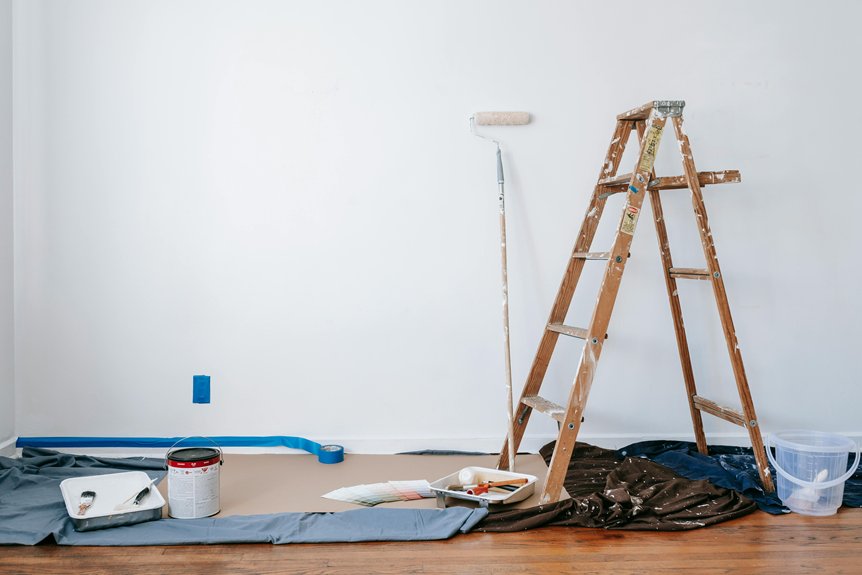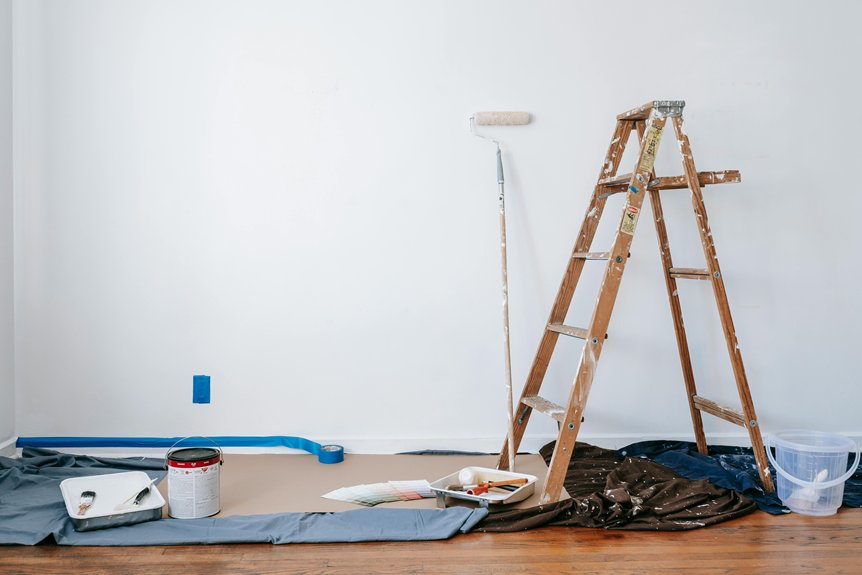Renovating a Tudor home can be a rewarding endeavor, but it requires a thoughtful approach to honor its unique architectural style. You’ll need to balance modern needs with historical preservation, ensuring that every decision reflects the home’s heritage. From selecting the right materials to enhancing energy efficiency, there are essential steps to reflect upon. Understanding these can set the foundation for a successful transformation that respects the past while embracing the future. What comes next might surprise you.
Key Takeaways
- Prioritize preserving original features like exposed beams and moldings, using restoration techniques to maintain architectural integrity.
- Source authentic period materials, ensuring sustainability and local support while aligning with Tudor design aesthetics.
- Hire experienced contractors specialized in historical renovations, verifying their credentials and past project references.
- Upgrade amenities with energy-efficient appliances and smart technology that enhance comfort without compromising historic charm.
- Optimize landscaping with formal hedges and traditional flowers to enhance the home’s character and curb appeal.
Understand the Historic Significance of Your Tudor Home

Understanding the historic significance of your Tudor home is essential for any renovation project.
Tudor architecture, characterized by its steeply pitched roofs, decorative half-timbering, and intricate masonry, reflects a unique historical context that emerged in England during the late 15th century. This style symbolizes a blend of medieval and Renaissance influences, showcasing craftsmanship and local materials.
As you commence your renovation, consider how your home’s features tell a story of its era. Researching its historical background not only enriches your understanding but also guides your design choices, ensuring they respect the architectural integrity and heritage of your Tudor home.
Preserve Original Features
While beginning your Tudor home renovation, preserving original features should be a top priority.
Start with thorough historical research to understand the unique elements of your home. Focus on restoration techniques that maintain the integrity of architectural details, like exposed beams and intricate moldings.
When working on windows, consider methods that restore rather than replace, ensuring you keep the original character intact. Engage skilled artisans familiar with Tudor design to handle delicate features.
Choose Appropriate Materials
When renovating a Tudor home, selecting appropriate materials is essential for authenticity and sustainability.
You should consider using authentic period materials to maintain historical integrity, while also exploring sustainable options that reduce environmental impact.
Additionally, sourcing locally can enhance your project by supporting community economies and ensuring better material quality.
Authentic Period Materials
Choosing authentic period materials is essential to guaranteeing your Tudor renovation reflects the historical integrity of the era.
To achieve this, focus on period specific woodwork, such as oak beams and handcrafted cabinetry, which can evoke the craftsmanship of the time.
Look for historically accurate finishes, like natural oils or traditional lime-based paints, to maintain authenticity and enhance the beauty of your home.
Incorporating these materials not only honors the Tudor style but also contributes to the overall aesthetic and value of your renovation.
Always consult with experts to verify your selections are true to the period and region.
Sustainable Material Options
Incorporating sustainable materials into your Tudor home renovation not only respects the environment but also enhances the overall character of the space. By choosing recycled materials and eco-friendly finishes, you can create a cohesive and historically sensitive design. Consider options like reclaimed wood for flooring, recycled glass tiles for backsplashes, and low-VOC paints to maintain air quality.
| Material Type | Benefits | Examples |
|---|---|---|
| Recycled Materials | Reduces waste | Reclaimed wood, metal |
| Eco-Friendly Finishes | Non-toxic, sustainable | Low-VOC paints |
| Natural Insulation | Energy-efficient | Wool, cellulose |
Local Sourcing Benefits
While renovating a Tudor home, sourcing materials locally can greatly enhance both the authenticity and sustainability of your project.
By choosing local artisans, you not only support their craftsmanship but also guarantee that the materials reflect the region’s historical context. This approach fosters community support, strengthening local economies and preserving traditional skills.
You’ll find unique, high-quality materials that align with Tudor aesthetics, such as hand-crafted bricks or reclaimed wood.
Plus, local sourcing often reduces transportation emissions, making your renovation more eco-friendly.
Involving the community in your renovation creates a meaningful connection to your home’s history and your neighborhood’s culture.
Focus on Energy Efficiency
When renovating your Tudor home, focusing on energy efficiency can greatly enhance comfort and reduce utility bills.
Upgrading insulation, installing energy-efficient windows, and exploring sustainable heating solutions are essential steps that not only preserve your home’s charm but also contribute to environmental sustainability.
Insulation Upgrades for Comfort
Upgrading insulation can greatly enhance your Tudor home’s energy efficiency, making it more comfortable year-round.
To achieve this, consider the following:
- Choose effective insulation materials: Fiberglass, cellulose, and spray foam are excellent options that provide strong thermal barriers.
- Seal gaps and cracks: Proper sealing prevents drafts, ensuring your insulation works efficiently.
- Focus on key areas: Insulate attics, walls, and basements to maximize comfort and energy savings.
Energy-Efficient Windows Benefits
Many homeowners overlook the significant impact that energy-efficient windows can have on a Tudor home’s energy consumption and comfort.
Upgrading to these windows means you’ll enjoy substantial energy savings, reducing your utility bills while maintaining the architectural charm of your home.
Various window styles, like double-hung or casement, offer not only aesthetic appeal but also advanced insulation properties.
Low-E glass coatings and argon gas fills enhance energy efficiency, keeping your home comfortable year-round.
Sustainable Heating Solutions
After enhancing your Tudor home with energy-efficient windows, consider how sustainable heating solutions can further improve comfort and reduce energy consumption.
Here are three options to explore:
- Solar Panels: Installing solar panels can greatly offset your heating costs by harnessing renewable energy, making your home eco-friendly.
- Radiant Heating: This system warms your home from the ground up, providing consistent warmth and reducing energy waste.
- Smart Thermostats: These devices optimize your heating schedule based on your habits, ensuring maximum efficiency and comfort.
Maintain Architectural Integrity
While renovating a Tudor home, it’s crucial to preserve its unique architectural integrity, as this style is characterized by distinct features such as steeply pitched roofs, decorative half-timbering, and leaded glass windows.
Focus on historical accuracy by researching original materials and techniques. For design consistency, maintain color palettes and patterns that reflect the era.
When replacing elements, choose options that replicate the original craftsmanship, ensuring you respect the home’s character.
This approach not only honors the Tudor style but also enhances your home’s value and appeal, making it a timeless treasure in your community.
Hire Experienced Contractors
Hiring experienced contractors is essential for a successful Tudor home renovation. They bring valuable expertise that guarantees your project respects the home’s unique characteristics.
Experienced contractors are crucial for a Tudor home renovation, ensuring respect for the home’s unique characteristics.
When selecting a contractor, consider these key factors:
- Contractor Credentials: Verify licenses, insurance, and past project references.
- Experience with Tudor Homes: Look for contractors who specialize in historical renovations to guarantee authenticity.
- Project Management Skills: Choose someone who can effectively coordinate timelines, budgets, and subcontractors.
Plan for Modern Amenities
Incorporating modern amenities into your Tudor home renovation can enhance comfort without compromising the house’s historic charm. Focus on creating a functional modern kitchen and making thoughtful bathroom upgrades. Consider energy-efficient appliances, smart technology, and high-quality fixtures that blend seamlessly with Tudor aesthetics.
| Aspect | Modern Approach |
|---|---|
| Kitchen | Open layout with contemporary finishes |
| Bathroom | Spa-like features and smart storage |
| Heating/Cooling | Energy-efficient systems |
| Lighting | LED fixtures that mimic vintage styles |
| Insulation | Eco-friendly materials |
These upgrades can elevate your living experience while honoring Tudor design.
Incorporate Landscaping That Compliments the Style

To create a cohesive look that enhances your Tudor home’s character, it’s essential to choose landscaping elements that reflect its architectural style.
Consider these garden design and outdoor features:
- Formal hedges: Use boxwood or yew to frame pathways and create structure.
- Stone pathways: Incorporate natural stone or gravel paths that mirror Tudor design elements.
- Herbaceous borders: Plant traditional flowers like foxgloves or hollyhocks for a timeless feel.
Be Mindful of Interior Layout
When renovating your Tudor home, it’s essential to optimize space utilization while maintaining the unique architectural features that define its character.
Consider how to enhance natural light throughout the interior, as this can dramatically affect the ambiance and functionality of each room.
Thoughtful planning in your layout won’t only preserve the home’s charm but also create a more inviting living environment.
Optimize Space Utilization
While optimizing space utilization in a Tudor home, it’s crucial to carefully evaluate the interior layout to enhance both functionality and aesthetics.
You can achieve this by implementing effective space-saving solutions and incorporating multifunctional furniture. Here are three strategies to contemplate:
- Use built-in storage: Create shelves or benches that blend seamlessly with your walls.
- Choose convertible pieces: Opt for a sofa bed or extendable dining table to maximize utility.
- Define zones: Use rugs or furniture placement to delineate areas, improving flow.
These thoughtful adjustments will help you make the most of your Tudor home’s unique charm.
Preserve Architectural Features
Preserving the architectural features of your Tudor home is essential, especially since these elements contribute considerably to its character and historical value.
Focus on restoration techniques that maintain the integrity of original materials, like wood beams and stonework.
When planning your interior layout, aim for feature highlighting; this means arranging furniture and decor to draw attention to unique elements, such as intricate moldings or arched doorways.
Avoid making drastic changes that disrupt the home’s flow or diminish its charm.
Enhance Natural Light
To enhance natural light in your Tudor home, it’s crucial to be mindful of your interior layout.
Consider implementing these light enhancing strategies:
- Open Spaces: Remove unnecessary walls to create open areas that allow light to flow freely.
- Strategic Furniture Placement: Arrange furniture away from windows to minimize obstruction and maximize light penetration.
- Window Treatments: Opt for sheer or light-colored window treatments that diffuse light without blocking it, preserving privacy while inviting brightness.
Embrace Color Schemes That Reflect Tudor Aesthetics
As you commence your Tudor home renovation, embracing color schemes that reflect the rich aesthetics of this architectural style can greatly enhance your space.
Consider using deep, earthy color palettes—think rich browns, muted greens, and warm burgundies. These hues evoke the historical charm of Tudor design while providing a cozy atmosphere.
For design inspiration, explore traditional textiles and artwork that feature these colors. Incorporating accent walls or painted beams in these shades can create visual interest and authenticity.
Ultimately, your choices won’t only showcase Tudor elegance but also create a harmonious living environment that feels both inviting and timeless.
Conclusion
Successfully renovating your Tudor home means honoring its unique heritage while blending modern comforts. By preserving original features, using authentic materials, and enhancing energy efficiency, you can maintain the architectural integrity that defines Tudor style. Thoughtfully planning your interior layout and landscaping guarantees functionality and aesthetic harmony. Embracing appropriate color schemes will further reflect the home’s historical significance. With these tips, you’ll create a beautiful space that respects the past while embracing the present.




